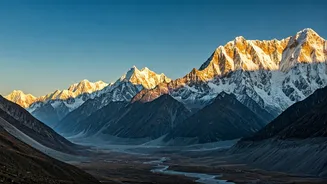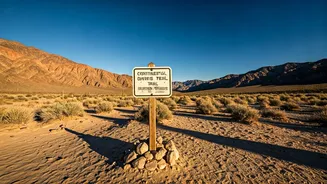Grand Teton's Majestic Beauty
Grand Teton, a peak in Wyoming, embodies the rugged beauty of the American West. Rising dramatically from the valley floor, its jagged peaks have captivated
explorers and artists for centuries. The Teton Range, including Grand Teton, offers a stunning array of granite spires and alpine lakes. Geologically, these mountains are relatively young, shaped by glaciers and tectonic forces, resulting in their distinctive, sharp profiles. Grand Teton National Park provides numerous recreational activities, including hiking, climbing, and boating on the Snake River. Its pristine environment is home to diverse wildlife such as elk, bison, and bears, enhancing the park's allure. The mountain's name is derived from French trappers, signifying the prominence of its peaks. The area's cultural significance extends to Indigenous peoples, who have a long-standing connection to the land. Grand Teton offers a blend of adventure and serene beauty, representing a key highlight for anyone visiting the United States and wanting to witness the awe-inspiring presence of the mountains.
Denali: Alaska's Giant
Denali, formerly known as Mount McKinley, dominates the Alaskan landscape, standing as the highest peak in North America. This colossal mountain, part of the Alaska Range, is known for its extreme conditions and imposing presence. The harsh climate, marked by freezing temperatures and strong winds, contributes to Denali's formidable reputation. Climbers face significant challenges, including altitude sickness, glacial hazards, and unpredictable weather, yet the summit remains a coveted goal. The park surrounding Denali is rich in wildlife, including grizzlies, caribou, and wolves, which have adapted to the unforgiving environment. Denali National Park and Preserve encompass millions of acres of untouched wilderness, providing a sanctuary for diverse ecosystems. The mountain's geological formation is a result of tectonic activity, constantly reshaping the landscape. Its significance extends beyond its height; it is a symbol of resilience and natural power. The indigenous communities have historical ties to this area, understanding its power and spiritual significance. The park's remote location enhances its appeal to those seeking true wilderness experiences, solidifying its place as a bucket list location.
Mount Rainier's Volcanic Splendor
Mount Rainier, a volcano in Washington State, is a striking landmark in the Pacific Northwest. Its snow-covered peak and surrounding glaciers are visible from miles away, showcasing its grandeur. This stratovolcano has a history of eruptions, shaping its dramatic slopes. The national park, established to protect its diverse ecosystems, is a popular destination for visitors. The mountain’s environment supports a diverse array of plant and animal life, including old-growth forests and alpine meadows. Hiking trails, such as the Wonderland Trail, provide access to scenic views and challenging terrain, offering adventures to outdoor enthusiasts. Mount Rainier's glaciers are constantly in motion, sculpting the landscape with their relentless power, while the surrounding forests provide an immersive experience. The mountain's name honors a British naval officer, reflecting a history of exploration and discovery. For those seeking adventure and natural beauty, Mount Rainier represents an important destination due to its volcanic activity, and unique environmental factors.
Mount Hood: Oregon's Icon
Mount Hood, towering over Oregon, is a prominent symbol of the state's beauty. This dormant volcano attracts skiers, climbers, and nature enthusiasts year-round. Its iconic cone-shaped peak is visible from Portland and other nearby areas. The mountain's environment supports a diversity of ecosystems. The Timberline Lodge, a historic structure, provides lodging and dining, offering breathtaking views. The mountain's geological structure is a result of volcanic activity. Mount Hood National Forest offers various recreational activities, including hiking, camping, and skiing. Its glaciers and snowfields provide water sources for local rivers and streams. The name Hood refers to a British admiral, showcasing a history of exploration and navigation. The mountain's presence has influenced local culture and traditions. The mountain's accessibility from Portland makes it a popular destination for a variety of visitors.
Great Smoky Mountains
The Great Smoky Mountains, straddling the border between North Carolina and Tennessee, form a range known for its mist-covered peaks and diverse ecosystems. The name comes from the fog, which hangs over the mountains, creating a mystical atmosphere. The area is part of Great Smoky Mountains National Park, a UNESCO World Heritage site and a haven for biodiversity. It is one of the most visited national parks in the United States. Its forests are home to a wide range of plant and animal life, including black bears, elk, and a variety of wildflowers. The park's numerous hiking trails and scenic drives provide opportunities to experience the natural beauty. The mountains' geology includes ancient rocks, sculpted over millions of years. The region has a rich cultural history, shaped by both Native American and European settlers. The Great Smoky Mountains offer an accessible wilderness experience for visitors of all levels. Their unique environmental characteristics and historical roots make them a valuable destination.













